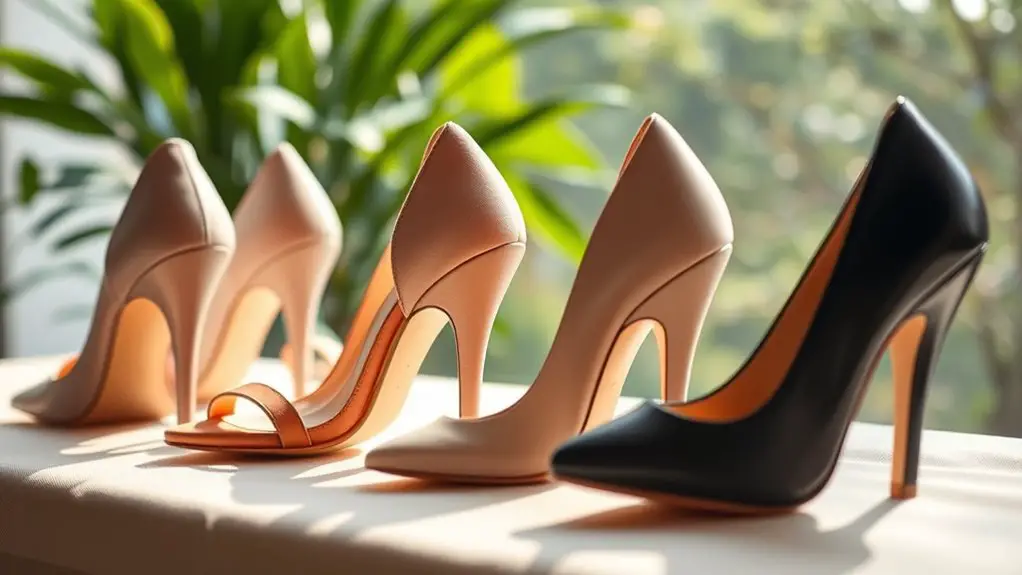When selecting heels with plantar fasciitis, prioritize comfort and support. Look for cushioned insoles that absorb shock and reduce pressure on your feet. Choose lower heel heights (1-2 inches) for stability, and guarantee good arch support to alleviate strain. Materials matter too; opt for breathable and flexible options. Finally, prioritize a proper fit by trying on various styles. Understanding these key elements will markedly improve your experience, and there’s more essential information to take into account.
Understanding Plantar Fasciitis and Its Impact on Footwear Choices

When you’re dealing with plantar fasciitis, understanding its nature can greatly influence your footwear choices. This condition often stems from factors like overuse, improper footwear, or biomechanical issues. Knowing these plantar fasciitis causes helps you realize that the shoes you choose can either alleviate or exacerbate your symptoms.
Footwear impact is essential since supportive shoes can help distribute weight evenly, reducing strain on your plantar fascia. High heels, for instance, might seem stylish, but they often lack the arch support and cushioning needed for comfort. This can lead to increased pain and further complications.
When selecting heels, consider those with a lower height and a wider toe box. These features can provide better stability and lessen the pressure on your feet. By prioritizing comfort and support in your footwear, you can manage your plantar fasciitis symptoms more effectively while still enjoying your favorite styles.
Look for Cushioned Insoles
When you’re dealing with plantar fasciitis, cushioning is key to reducing discomfort and providing support. There are various types of cushioned insoles available, each designed to address different needs, so it’s important to find the right fit for your heels. Brands and models often recommended by experts can guide you in making a choice that prioritizes your comfort and foot health.
Importance of Cushioning
Choosing the right heels can make all the difference, especially if you’re dealing with plantar fasciitis. The importance of cushioning can’t be overstated, as it directly impacts your comfort and support. Cushioned insoles provide significant cushioning benefits, absorbing shock and reducing pressure on your feet. This is vital for alleviating the pain associated with plantar fasciitis. Look for heels that incorporate advanced cushioning technologies, such as memory foam or gel inserts, which contour to your foot’s shape and enhance overall comfort. These features help distribute weight evenly, minimizing strain on your arches. Prioritizing cushioning not only makes your heels more bearable but also promotes better foot health, allowing you to enjoy your time on your feet without unnecessary discomfort.
Types of Cushioned Insoles
While cushioning plays a critical role in selecting heels for plantar fasciitis, the type of cushioned insoles you choose can further enhance your comfort. Different insole materials like memory foam, gel, and EVA provide varying levels of support. Memory foam, for instance, molds to your foot shape, offering personalized cushioning. Gel insoles use advanced cushioning technologies to absorb shock, reducing pressure on your heels. Meanwhile, EVA is lightweight and provides a balance of flexibility and support. When selecting insoles, consider your specific needs—do you require extra arch support or shock absorption? Finding the right combination of cushioning technologies and insole materials can make a significant difference in your comfort when wearing heels, helping you manage plantar fasciitis more effectively.
Recommended Brands and Models
Finding the right cushioned insoles can greatly impact your comfort and support when wearing heels, especially if you’re managing plantar fasciitis. Popular brands like Dr. Scholl’s and Superfeet offer specific models designed to alleviate foot pain. For instance, Dr. Scholl’s Comfort Insoles feature a gel cushioning system that absorbs shock, while Superfeet’s Green insoles provide arch support and stability. Another excellent option is Spenco’s Total Support insoles, which are known for their deep heel cup and cushioning. Consider trying these brands to find the perfect fit for your needs. Remember, investing in quality insoles can make a significant difference in how you feel while wearing your favorite heels, allowing you to enjoy them without sacrificing comfort.
Choose the Right Heel Height
When selecting heels, the right heel height is essential for managing plantar fasciitis. You’ll want to balance comfort and style, as a higher heel may look great but can exacerbate your condition. Look for supportive cushioning features that can help alleviate pressure on your feet while you enjoy your stylish choices.
Optimal Heel Height
Choosing the right heel height can greatly impact your comfort and overall foot health, especially if you’re dealing with plantar fasciitis. You want to evaluate heel height carefully, as it can exacerbate your symptoms. Aim for a heel height that provides support without compromising style. Here are some heel height considerations to keep in mind:
- Low heels (1-2 inches): Offers more stability and less strain on your arches.
- Mid heels (2-3 inches): Can be stylish alternatives, but choose wisely.
- High heels (over 3 inches): Often best avoided, as they can lead to increased pain.
Balancing comfort with fashion is key; there are many stylish options available that won’t sacrifice your foot health.
Comfort vs. Style
While you might be tempted to prioritize style over comfort in your heel selection, striking the right balance is essential for managing plantar fasciitis. Choosing the right heel height can greatly impact your foot health. Look for heels that align with your style preferences while incorporating vital comfort features, such as a lower height or a wider base. Consider options like block heels or wedges, which provide stability without sacrificing aesthetics. Remember, it’s possible to find stylish heels that won’t exacerbate your condition. By focusing on a design that offers both appeal and adequate support, you can enjoy your favorite looks without compromising your well-being. Prioritize what feels good for your feet, and you’ll feel confident in your choices.
Supportive Cushioning Features
Finding the right heel height is just one part of the equation; supportive cushioning features play a significant role in your overall comfort. When dealing with plantar fasciitis, it’s essential to choose heels with advanced cushioning technology and adequate shoe flexibility. These elements help reduce strain on your feet, providing relief during wear.
Consider the following when selecting your heels:
- Memory foam insoles: They mold to your foot’s shape, offering personalized support.
- Arch support: Look for shoes that incorporate arch support to alleviate pressure on your plantar fascia.
- Shock-absorbing materials: These can help minimize impact and enhance comfort throughout the day.
Opt for Arch Support
If you want to alleviate discomfort from plantar fasciitis while still enjoying the elegance of heels, prioritizing arch support is vital. Arch support benefits include reducing strain on your feet, improving alignment, and providing stability, which can make a significant difference in your comfort level throughout the day. When searching for heels, look for reputable arch support brands known for their commitment to foot health, such as Vionic or Clarks. These brands often incorporate innovative support systems designed to accommodate the unique needs of your arches. By choosing heels with built-in arch support, you’ll not only enhance your comfort but also enjoy the confidence that comes from knowing your footwear is doing its part to protect your feet. Remember, investing in quality heels with proper arch support is important for both style and well-being, enabling you to navigate your day with less pain and more grace.
Consider the Material of the Shoes

Choosing the right material for your heels can greatly impact your comfort when dealing with plantar fasciitis. The shoe construction plays a vital role in how your feet feel throughout the day. You’ll want to look for materials that offer both support and flexibility, allowing your feet to move naturally without added strain.
Choosing the right heel materials significantly influences comfort for those with plantar fasciitis, balancing support and flexibility for natural movement.
Here are some materials to take into account:
- Leather: Known for its durability and ability to mold to your foot shape, providing a custom fit over time.
- Mesh: Offers breathability and flexibility, allowing for better airflow and comfort during extended wear.
- Cushioned synthetics: These materials often provide excellent shock absorption, reducing the impact on your heels.
Prioritize Stability and Balance
While it might be tempting to opt for the latest trendy heel, prioritizing stability and balance is essential for those dealing with plantar fasciitis. A well-thought-out heel design can considerably affect your comfort levels and overall foot health. Look for shoes that feature a wider base and lower heel height to enhance weight distribution, reducing strain on your feet.
| Feature | Importance | Benefits |
|---|---|---|
| Wider Base | Provides stability | Reduces the risk of ankle rolls |
| Lower Heel Height | Enhances balance | Minimizes pressure on the arch |
| Cushioned Footbed | Absorbs impact | Increases comfort during wear |
| Arch Support | Maintains alignment | Promotes better weight distribution |
Try Before You Buy: The Importance of Fitting

How can you guarantee your heels won’t exacerbate your plantar fasciitis? The key lies in proper fitting. You should never underestimate the importance of trying on shoes before you buy them. Utilize effective fitting techniques and shoe measuring to ascertain you’re selecting the right size and shape for your feet.
Proper fitting is essential to ensure your heels don’t worsen plantar fasciitis; always try shoes on before purchasing.
- Consider your foot shape: Is it wide, narrow, or somewhere in between?
- Pay attention to arch support: Does the shoe provide the support you need?
- Walk around: Test the shoes on different surfaces to assess comfort and stability.
Frequently Asked Questions
Can Wearing Heels Worsen Plantar Fasciitis Symptoms?
Wearing heels can indeed worsen plantar fasciitis symptoms. The heel height impact and lack of foot arch support in many styles may lead to increased strain on your feet, exacerbating discomfort and inflammation. Consider alternatives for relief.
Are There Specific Heel Styles to Avoid?
Think of heels as a double-edged sword; some heel types, like stilettos or high wedges, can compromise comfort levels, exacerbating discomfort. Avoid these styles to guarantee your feet remain supported and pain-free. Prioritize stability instead.
How Often Should I Replace My Heels?
You should replace your heels every 6 to 12 months, depending on usage. Look for replacement signs like worn soles or discomfort. A shorter heel lifespan can affect your comfort and foot health considerably.
Can Custom Orthotics Be Used in Heels?
Yes, custom orthotics can be used in heels, providing benefits like improved arch support and cushioning. However, consider heel height carefully, as excessive elevation may undermine these benefits and exacerbate discomfort.
Is It Safe to Wear Heels Daily With Plantar Fasciitis?
Wearing heels daily with plantar fasciitis isn’t ideal. Consider heel height carefully and prioritize daily comfort tips, like using cushioned insoles. Your feet need support, so be mindful of how heels affect them over time.



